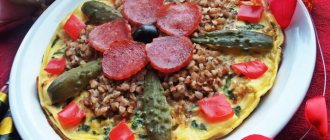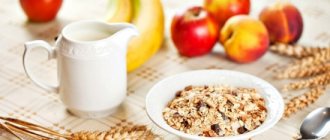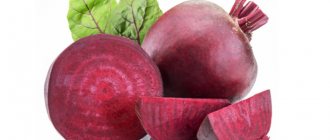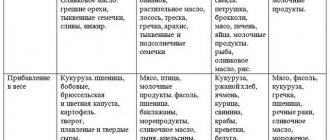- Food
- Basic Rules
- Quitting the diet
- Duration
- Effect on the body
- Contraindications
- Sample menu
- results
One of the effective ways to lose weight is a vitamin-protein diet, which has many advantages.
It does not cause a painful feeling of hunger, involves separate nutrition and does not allow the body to become depleted. There are several varieties of it, but the basic principles remain unshakable. If you stick to them for a certain time, you can achieve good results. To ensure that the protein-vitamin diet does not disappoint, you need to learn its rules and follow them. If any doubts arise, it is advisable to consult a nutritionist or doctor. And the most important thing in this weight loss process is the selection of products.
Food
According to its name, a protein-vitamin diet for weight loss involves the active consumption of two groups of foods: protein and vitamin. In this case, carbohydrates and fats are completely excluded. When creating a menu, be sure to be guided by two lists - what you can eat and what you cannot eat.
Authorized products:
- eggs;
- low-fat varieties of dairy products: cheese, cottage cheese, feta cheese;
- poultry: chicken, turkey;
- beef, rabbit;
- lean fish;
- seafood;
- vegetables;
- fruits.
Prohibited products:
- drinks: coffee, fruit and vegetable juices, alcohol, soda;
- smoked meats;
- fats: lard, butter, cream;
- carbohydrate-containing products: pastries, bread, cereals, chocolate, sweets, dried fruits;
- any dressings: sauces, sour cream, mayonnaise, mustard, seasonings, ketchup;
- potatoes - they contain carbohydrates;
- grapes, bananas, persimmons, apricots, mangoes, papaya, melon - they are very sweet for the diet;
- nuts;
- corn, peas.
Please understand that the menu of a protein-vitamin diet includes only those foods that contain a lot of protein and vitamins. But carbohydrates and fats are prohibited here. And these are not the only rules that you will have to follow when losing weight this way.
Vitamin-protein diet for 5 days
During the day, meals rich in protein and vitamins replace each other, so the metabolic rate in the body increases. A protein-vitamin diet for weight loss is often used, the menu of which is designed for 5 days. The main rule: meals occur every 2-2.5 hours, with a clear change of protein and vitamin products. The main limitation: do not allow a change in order, otherwise the diet will not be effective.
There are two menu options for a protein-vitamin diet for weight loss, designed for 5 days: strict and with the addition of carbohydrates. With the strict type, food intake involves consuming protein and vitamin foods throughout the day from 8 a.m. to 8 p.m.
Menu for Monday:
- breakfast: white from two chicken eggs;
- lunch: grapefruit;
- lunch: boiled beef (portion 0.2 kg);
- afternoon snack: pears, 2 pieces;
- dinner: boiled chicken meat, serving 100 g.
Tuesday menu:
- breakfast: cottage cheese 100 g, you can add raisins;
- lunch: pineapple 100 g;
- lunch: 200 g of boiled fish;
- afternoon snack: apples, 2 pieces;
- dinner: chicken meat cooked in the oven (portion 150 g).
Menu for Wednesday:
- breakfast: cheese with low fat content, 50 g is enough;
- lunch: orange;
- lunch: boiled turkey meat, serving 150 g;
- afternoon snack: plums – 2 pieces;
- dinner: lean beef, baked in the oven, serving 150 g.
Thursday:
- breakfast: 50 g feta cheese;
- lunch: 2 apricots;
- lunch: 200 g of boiled fish;
- afternoon snack: cabbage salad
- dinner: boiled turkey, 150 g is enough.
Menu for Friday:
- breakfast: piece of cheese, 50 g;
- lunch: 2 peaches;
- lunch: boiled rabbit meat, 200 g;
- afternoon snack: tomato and cucumber salad;
- dinner: portion (150 g) of boiled chicken.
If it is difficult to follow a strict diet, you can try adding carbohydrates. The main difference is that meals on the diet occur from 8 a.m. to 6 p.m., and dinner should be carbohydrate-based. Porridge is best. This addition to the vitamin-protein diet has the most positive reviews and results. Weight loss is not much lower. But such food restriction is much easier to bear.
Basic Rules
Those who have already tried to fight excess weight know that any diet (and vitamin-protein diet is no exception) involves not only food restrictions. There are many small but important nuances that allow you to increase your results and lose weight as quickly as possible. Follow the recommendations of nutritionists - and the numbers on the scales will not disappoint you.
- Follow the principle of fractional meals: eat small portions every 2.5 hours 5-6 times a day.
- As part of a vitamin-protein diet, meat, fish, and vegetables are steamed, stewed, boiled or baked.
- Protein foods and vitamin complexes are consumed separately in the following order: protein foods should be breakfast, lunch and dinner, vitamin foods should be lunch, afternoon snack and a snack before bedtime.
- Fruits and vegetables included in the menu should be medium in size. Their daily volume should be at least 400 grams, otherwise stomach problems in the form of constipation and flatulence cannot be avoided due to the abundance of proteins in the diet.
- Portions for lunch and dinner should not exceed 200 grams.
- Provide your body with plenty of fluids. This can be green and herbal teas, decoctions, still mineral water.
- A vitamin-protein diet for weight loss is also good because it allows you to engage in light sports: swimming, cycling, shaping, aerobics.
- In the evenings, it is advisable to take half-hour walks in the fresh air.
- It is important to follow a daily routine: eat at the same time, sleep at least 8 hours a day.
At first, the rules of a protein-vitamin diet may seem easy. However, not everyone manages to adhere to them exactly. Some people get tired of bland meat and steamed fish without seasoning, some complain about a monotonous menu without sweets, others constantly forget to drink enough liquid. So you will still have to muster your willpower and limit yourself in some way while losing weight.
The principle of operation of the method
There are two options for this diet. But they are all based on the alternate use of protein and vitamin products.
Look at the same topic: A diet for losing weight by 7 kg in a week will help you lose weight quickly
The first involves a diet lasting ten days, during which you can eliminate up to five kilograms of excess weight. At this time, food that contains simple carbohydrates is completely excluded from the diet, while fats in small quantities will enter the body with protein foods, for example, cottage cheese or meat.
Seasonings and sauces should not be used; salt should be present in minimal quantities.
Protein and vitamin foods are alternated hourly. Meals take place from eight o'clock in the morning to half past eight in the evening, with breaks between meals of two and a half hours. You can drink unsweetened and still water, green tea, and herbal infusions in any quantity daily.
According to the second option, a protein-vitamin diet is calculated for 2 weeks. Thanks to this technique, you can also lose up to seven kilograms of weight. In this case, it is not the hours that alternate, but the days, that is, every two days you need to change protein foods to vitamin foods. Everything else remains unchanged.
Regardless of the options, the diet operates according to the following principle:
- During “protein” hours or days, only protein foods should be consumed. It is allowed to use fish, chicken or beef meat, eggs, fermented milk and dairy products, including feta cheese, cheese, cottage cheese, as well as high-quality boiled sausage.
- During “vitamin” hours or days, you are allowed to consume any unsweetened vegetables and fruits, including citrus fruits, herbal infusions and tea, but do not use sugar. Vegetables are best consumed raw, but they can be stewed, baked or boiled.
Vitamin and protein meals should be consumed in turns with breaks of two hours or two days. You can eat garlic, it helps speed up your metabolism.
This diet will make it possible to speed up metabolic processes in the body, eliminate fat deposits, as a result of which body weight will gradually decrease, and the results obtained will be maintained for a long period of time, that is, the extra pounds will not return.
Quitting the diet
You need to be extremely careful when leaving the vitamin-protein diet. There are two reasons for this. Firstly, so that the stomach can gradually switch to carbohydrate and fatty foods without complications. Secondly, so that the extra pounds lost with such difficulty do not return again in a matter of days.
- On the first day of leaving the diet, add 100 ml of cereal porridge for breakfast, and for lunch, eat 100 grams of a side dish of buckwheat or rice.
- On the second day, increase these portions to 150 grams, and at dinner treat yourself to a salad dressed with sauce or oil.
- On the third day, you can include something sweet in the menu.
- On days 4 and 5, cook some pork, lamb or some fatty fish.
- On the sixth day you can try coffee.
- After a week, you can return to your usual diet.
If you exit the protein-vitamin diet wisely, and then also adhere to proper nutrition, the lost kilograms will not return. The result will depend largely on the duration of weight loss.
Some rules and recommendations
When using a protein-vitamin diet, you are allowed to consume a wide variety of foods, but there are also some restrictions:
- You should not eat sweets, sugar, flour products, or dried fruits;
- You cannot eat grapes and bananas, as well as nuts, potatoes, peas, corn, persimmons and mangoes;
- It is not recommended to eat lard, butter, smoked meats, sausages, bread and cereals;
- It is necessary to exclude seasonings, sauces and ketchups, mayonnaise from the diet;
- Avoid consumption of soda, store-bought juices, sugary drinks and alcohol;
- It is best when one serving of vegetables or fruits is two fruits; if meat is used, then the serving should be one hundred and fifty grams;
- You are allowed to eat fifty grams of cheese and one sausage at a time. Such products should be consumed only in the first half of the day.
Look at the same topic: Secrets of losing weight on a diet from Anita Tsoi
Duration
Nutritionists do not recommend living for more than a week without carbohydrates and fats, as this negatively affects the functioning of the stomach and some internal organs. Despite this, there is a protein-vitamin diet for 10 days and even 14. However, with such long-term weight loss, you will need to include some fatty and carbohydrate-containing foods in the menu at least once a day. It can be:
- a teaspoon of sugar or honey for breakfast tea;
- a teaspoon of flaxseed oil for dressing vegetable salad for lunch or afternoon snack;
- 100 grams of pasta, rice or buckwheat for dinner.
So, when choosing a vitamin and protein menu for the week, you will not go wrong with the results. It will be much more difficult to lose weight in this way for a longer period - 10, 14 days, or even a month. And, of course, it is better to familiarize yourself in advance with what will happen to your body during these periods.
Interesting fact. The vitamin-protein diet is one of the few that allows salt. True, in very minimal quantities.
“Appetizing” protein-vitamin diet: delving into the essence
The name “vitamin-protein diet” sounds very appetizing. Indeed, what could be better than fresh vegetables, juicy fruits and delicious protein products? However, this seemingly ideal diet also has its own rules. And you can achieve the desired result only by following these rules.
The protein vitamin diet for weight loss is based on the principles of separate nutrition and restriction of carbohydrates and fats in favor of fresh fruits and protein foods. Increasing the proportion of protein consumption while reducing the amount of fat and carbohydrates provides a significant acceleration of the process of burning adipose tissue. Alternating vitamin and protein foods promotes metabolism switching and significant weight loss. That is why products with proteins and vitamins are taken separately at different times. Fractional meals prevent the development of hunger and allow you to get by in small portions.
What foods should you look for proteins and vitamins in?
Foods rich in proteins and allowed in this diet include: eggs, fish, meat, chicken, cottage cheese, feta cheese, cheese, lean game, good quality boiled sausage.
Vitamins are found in any vegetables and fruits (cabbage, cucumbers, tomatoes, beets, oranges, tangerines, apples, pears, plums, peaches, apricots, etc.).
You can drink unlimited quantities of purified water, herbal infusions and tea without sugar.
Tangible prohibitions
Despite the fairly wide list of products that can be consumed during the vitamin-protein diet, there are also significant limitations in this nutritional method.
Any sweet foods should be completely excluded from the diet - cakes, sweets, cookies, marmalade, pastries, marshmallows, rolls and dried fruits. You should also not eat nuts, persimmons, grapes, bananas, lychees and mangoes, potatoes, peas and corn.
Taboos are also introduced on fatty foods: butter, lard, cream, boiled pork, smoked sausage, as well as carbohydrate foods: cereals and bread. When going on such a diet, you can forget about sauces, ketchups, mayonnaise and hot spices. The list of permitted drinks excludes: any carbonated water, store-bought juices, tea and coffee with sugar, and all types of alcohol.
Effect on the body
Separate nutrition, which forms the basis of a vitamin-protein diet, has many positive aspects. It has a great effect on the functioning of many internal organs, especially the stomach, and also promotes weight loss. Judge for yourself.
- Due to frequent meals and a varied menu, the feeling of hunger is practically not felt.
- The body does not feel a lack of proteins and vitamins, which means that the basic processes occurring in it will not be disrupted.
- Separate nutrition normalizes digestion. Products are absorbed with less energy consumption, but more fully. The processes of decay are eliminated.
- The functioning of the immune system improves.
- It is easier to overcome stress and depression.
- Body weight is normalized.
However, one should not overestimate the vitamin-protein diet, which also has negative sides. Sometimes such weight loss is complicated by decreased performance due to the lack of carbohydrates. A deficiency of fats can worsen the condition of the nervous system (they are building materials for nerve cells) and the circulatory system (they normalize blood clotting). In addition to these complications, you also need to keep in mind the contraindications that exist for this weight loss technique.
Helpful advice. As part of a protein-vitamin diet, you will have to eat a lot of citrus fruits enriched with vitamin C. Please note that its excess is fraught with increased blood pressure, impaired kidney function and insomnia.
Contraindications
Some people cannot lose weight with a protein-vitamin diet. There are a number of contraindications for it:
- active sports, especially professional sports;
- pregnancy;
- lactation;
- kidney problems;
- diseases of the gastrointestinal tract;
- significant mental and physical activity, which requires carbohydrates, while a vitamin-protein diet excludes their use;
- gallstones;
- allergy to citrus fruits;
- malfunctions of the genitourinary system.
The fact is that restricting the body in carbohydrates and fats affects the functioning of some internal organs. And if there were any problems with them even before losing weight, you will have to abandon the protein-carbohydrate diet, as their condition will only worsen. You will have to fight extra pounds using other methods. Well, if everything is normal, all that remains is to start creating a menu.
Keep in mind. You should not go on a protein-vitamin diet during exams or when completing a critical project at work, since the body simply needs carbohydrates at these moments.
Power System Principles
The principles of the protein-vitamin diet (people's reviews note that this method of losing weight ensures the loss of extra pounds in record time and without harm to health) is based on separate nutrition. Includes foods containing protein and vitamin-rich foods. Reception of products is limited. Menu components are consumed alternately, every 2-2.5 hours. Up to six times a day. The intervals between meals are short, and the body does not have time to feel hunger.
The diet places restrictions on the consumption of carbohydrates and fats. At the same time, the body receives a sufficient amount of vitamins that charge the body with energy and support life-support functions.
The essence of the diet is that the stomach digests a one-ingredient dish faster than a dish with a large number of ingredients. Because of this, metabolic processes are accelerated. The absorption of fewer substances is ensured. And fats, since they do not enter the body, are consumed from reserves. As a result, weight decreases.
The main thing is that when following this diet, the body receives all the necessary nutrients: proteins, minerals and vitamins. This does not upset the balance of nutrients and makes the diet gentle. Such nutrition helps to avoid feelings of hunger and, as a result, mood swings and stress. The menu items are simple. Their preparation does not require significant time investment.
A balanced and effective vitamin-protein diet for 10 days. You can easily lose 5-7 kilograms on it if you follow your diet and do not disrupt the nutrition system.
Sample menu
To create a menu for 10 days for a vitamin-protein diet, focus on the diet scheduled for the week, since it is considered the best option for safe weight loss. Then you can simply repeat: for the 8th day use the menu of the first, for the 9th - the second, etc.
The first day
- For breakfast: 2 boiled eggs, herbal tea.
- For lunch: grapefruit.
- For lunch: steamed chicken breast.
- For afternoon snack: 2 apples.
- For dinner: boiled fish.
- For a snack: orange.
Second day
- For breakfast: steamed protein omelette, green tea.
- For lunch: 2 tomatoes.
- For lunch: cottage cheese, cheese.
- For afternoon tea: 2 pears.
- For dinner: stewed turkey.
- For a snack: pomelo.
Day three
- For breakfast: cottage cheese with herbs, herbal tea.
- For lunch: cucumber.
- For lunch: boiled beef.
- For afternoon tea: 2 tangerines.
- For dinner: steamed chicken.
- For snack: 2 kiwis.
Day four
- For breakfast: boiled squid, green tea.
- For lunch: 2 apples.
- For lunch: stewed turkey.
- For afternoon tea: a few radishes.
- For dinner: steamed fish.
- For a snack: lettuce.
Day five
- For breakfast: cottage cheese with herbs, green tea.
- For lunch: some pineapple.
- For lunch: boiled beef.
- For afternoon snack: steamed eggplants.
- For dinner: seafood.
- For snack: 2 kiwis.
Day six
- For breakfast: 2 boiled eggs, herbal tea.
- For lunch: grapefruit.
- For lunch: stewed rabbit.
- For afternoon snack: tomatoes.
- For dinner: boiled chicken.
- For a snack: orange.
Day seven
- For breakfast: shrimp, green tea.
- For lunch: 2 pears.
- For lunch: steamed chicken breast.
- For afternoon tea: stewed zucchini.
- For dinner: steamed fish.
- For a snack: some pineapple.
Based on this, it’s easy to create a menu for 14 days or even a month. You can swap things around and repeat the diet of individual days. The main thing is to try to diversify the products, although their limited list makes this difficult. And all that remains is to wait for the results.
For comparison. 100 grams of boiled chicken without salt, seasonings and skin contains about 160 calories, turkey and rabbit - 200, beef - 190.
Protein diet for weight loss - sample menu for a week
When choosing dishes for a non-strict protein diet, take into account your own taste preferences: you don’t have to strictly adhere to the given menu, you can swap dishes, experiment with ingredients within the permitted list and overall serving size.
If you decide to follow a protein diet for longer than seven days, the menu for 10 days or 14 days will not be fundamentally different: on the eighth day, repeat the diet of the first day, etc.
The protein diet menu for weight loss for 7 days and 2 weeks is shown in the table below. Each sentence is a description of one meal.
| Day | Menu |
| 1st | Tea or coffee (without sugar, with skim milk). Green salad dressed with balsamic vinegar, 1-2 boiled eggs. 100 g of rice, boiled poultry fillet (without skin) - 150 g. 100 g of cottage cheese, protein shake.. Vegetable salad and 150 g of steamed fish. Tomato juice |
| 2nd | Tea or coffee. Green salad dressed with balsamic vinegar, 1 grain toast. 100 g rice, 150 g boiled or steamed fish. Vegetable salad without salt. 200 g of boiled meat (poultry fillet or beef). Protein shake. |
| 3rd | Tea or coffee. 1 orange, 1 kiwi, 2 boiled eggs. Green salad, 1 egg. Vegetable salad without dressing, protein shake. 200 g of boiled or baked meat. Green tea. |
| 4th | Tea or coffee. 1 egg, 50 g hard cheese. Baked eggplant or zucchini. 1 orange, protein shake. Vegetable Salad. A glass of apple juice. |
| 5th | Tea or coffee. Salad of boiled or fresh vegetables. 100 g rice, 150 g fish (boiled, baked, steamed). Carrot salad. 1 apple, protein shake. A glass of tomato juice. |
| 6th | Tea or coffee. Boiled egg with vegetable salad. 100 g rice, 200 g chicken. Vegetable Salad. 1 egg with carrot salad. Green tea. |
| 7th | Tea or coffee. 1 orange. 200 g chicken meat. 200 g cottage cheese, protein shake. Vegetable Salad. A glass of kefir. |
Cocktail recipes for a protein diet for weight loss:
- Mix skim milk (320 g) and low-fat yoghurt (120 g) thoroughly.
- Mix low-fat yogurt (120 g), milk (320 g), 60 g strawberries, 1 tablespoon flax seeds.
results
The results will depend on the initial weight and the strictness of adherence to the vitamin-protein diet menu. The fewer extra pounds you plan to lose, the less the result will be - this is the paradox of all weight loss methods. According to reviews and statements of nutritionists, you can ultimately achieve the following figures:
- in 7 days - minus 3-5 kg;
- for 10 - 5-7 kg;
- for 14 - 7-8 kg;
- for 21 - 8-9 kg;
- per month - 10 kg.
A vitamin-protein diet is worth trying to lose weight with its help. The only caveat is that you don’t need to fast for too long. Remember that the body will demand its own - that is, fats and carbohydrates, without which it will have difficulty coping with certain tasks.
We also recommend reading: “Protein-vegetable diet.”
Restrictions and contraindications
Nutritionists emphasize that a vitamin-protein diet can be used in the absence of health problems. This technique is not recommended for people with pathologies of the gastrointestinal tract, liver and kidneys. It is also not necessary to use it during pregnancy and during breastfeeding. For those who play sports or lead an active lifestyle, the diet course should be halved.
You cannot adhere to such a diet for more than fourteen days, but you can apply the principle of the diet in later life, combining it with physical activity or sports. The duration of the secured result will depend on the person’s future lifestyle. It is recommended to adhere to a proper balanced diet, an active lifestyle, and normalization of sleep and wakefulness.
The amount of vegetables consumed per day should not exceed four hundred grams, as there is a risk of developing flatulence and constipation.
The diet is not suitable for those people who are engaged in mental activity and who work a lot. In such cases, you need a diet that includes carbohydrates.










